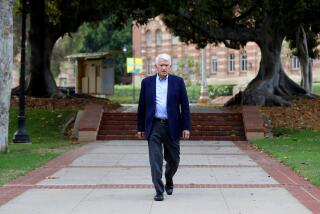Scientists Lower Estimated Chance of Major Bay Area Quake
The U.S. Geological Survey and its research partners downgraded Tuesday their estimate of the probability of a magnitude 6.7 or larger earthquake occurring within the next 30 years in the San Francisco Bay Region to 62%, less than their last estimate of 70% in 1999.
Quake scientists explained the change by saying that additional seismic models are now being used. Moreover, they said, the reduced estimate came from a reconciliation of controversy within a working group of scientists over whether a period of reduced stress caused by the 1906 San Francisco quake has continued.
Still, the scientists acknowledged the high uncertainty involved in these probability estimates. In fact, there is a wide variation in many of the forecasts. In an example of this tentativeness, scientists said that while using the 62% overall figure, they can be 95% sure that the probability of a 6.7 quake or larger in the next 30 years ranges between 37% and 87%.
The region covered is between Healdsburg on the north and Salinas on the south and is formally designated the Bay Region rather than Bay Area. The 6.7 figure corresponds with the magnitude of the 1994 Northridge quake, which caused 57 fatalities and $40 billion in damage. Such a quake in the Bay Area would entail great damage and likely some loss of life.
Paul Reasenberg, a research seismologist who was part of the working group that developed the new estimates, said in an interview that the 37% to 87% span of probabilities reflected differences between four separate seismic models used, with the lowest close to 37% and the highest close to 87%.
Some of the models reflect recorded quakes in the last 150 years -- when written records were being kept in California -- and others are perceived averages of quakes that have occurred or are expected to occur over thousands of years.
The 62% overall estimate, Reasenberg said, is used to trigger earthquake insurance rates set by the California Earthquake Authority, probabilities used on state quake hazard maps, and long-term planning by some private industries. Different probability estimates elsewhere in the state trigger different rates and assessments in those areas.
The last overall probability announced by scientists for Southern California was in November, when they estimated there was an 85% chance of a magnitude 7.0 or larger earthquake in the next 30 years.
In Southern California, there have already been two such quakes since the 1980s, when scientists first made estimates: the 7.3 Landers temblor of 1992 and the 7.1 Hector Mine temblor of 1999. Both, centered in sparsely populated areas of the Mojave Desert, caused comparatively minor damage and injuries.
Bill Ellsworth, who leads earthquake research for the Geological Survey’s western region, said Tuesday that scientists are aware “there is a wide uncertainty in all these estimates.
“But with all these models, the risk is significant,” he said. “We shouldn’t ignore the message that large quakes are going to occur in California, and we must be prepared for them.”
The probabilities released Tuesday also included estimates for major faults. For instance, scientists said there is a 21% overall probability of a quake of magnitude 6.7 or larger on the San Andreas fault in the Bay Region in the next 30 years. They are 95% confident that the range of probabilities varies from 2% to 45%.
The most devastating big quake in the Bay Region could well be on the Hayward/Rodgers Creek fault system, which passes through the East Bay cities of Berkeley and Oakland. The overall probability of a magnitude 6.7 or larger quake was placed at 27% on the Hayward/Rodgers Creek system. Scientists said they were 95% sure the likelihood of such a quake was between 10% and 58%.
There is also a 14% overall probability of such a quake on none of the major faults in the Bay Region, but on an unknown or little-known fault. The scientists’ “95% confidence level” of such a quake was between 7% and 37%.
Reasenberg noted that five large recent quakes in California have occurred on such faults -- including the Coalinga, the Loma Prieta, the Landers, the Northridge and the Hector Mine, in chronological order.
More to Read
Start your day right
Sign up for Essential California for news, features and recommendations from the L.A. Times and beyond in your inbox six days a week.
You may occasionally receive promotional content from the Los Angeles Times.






